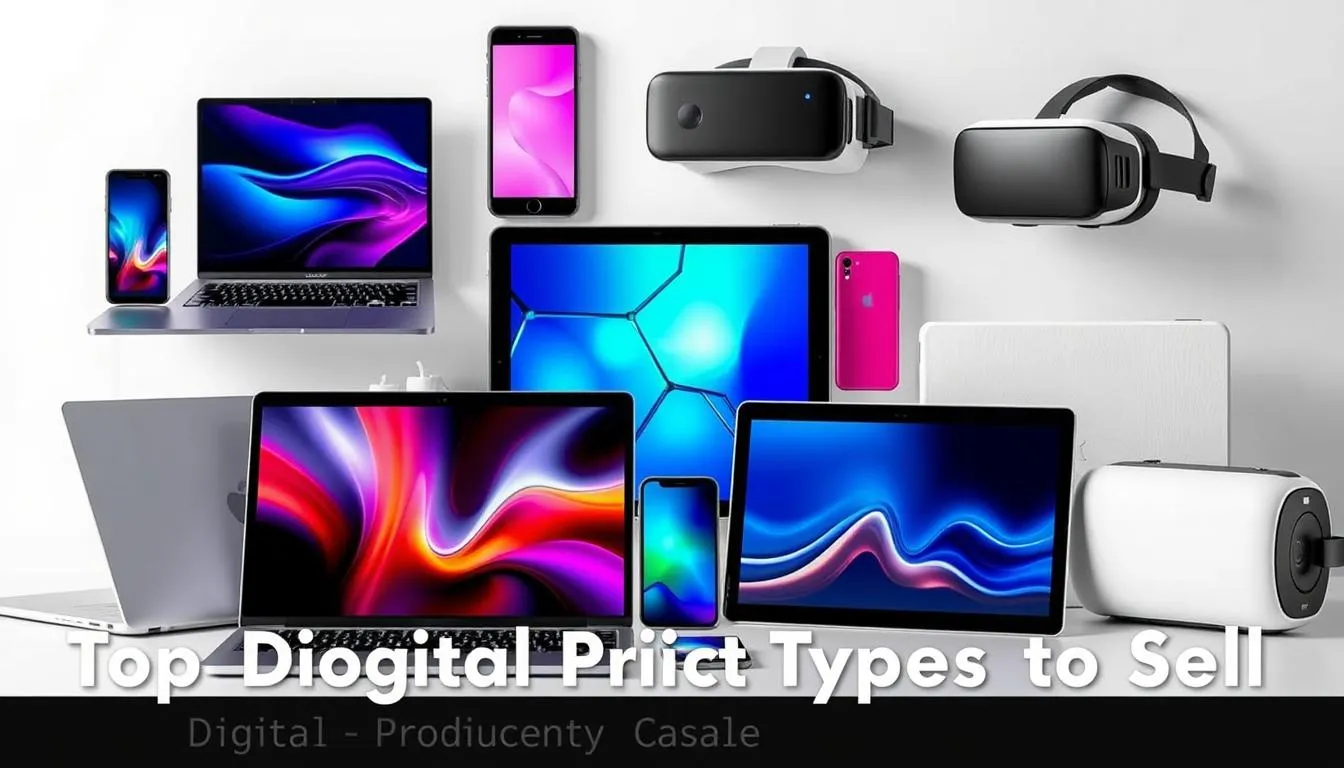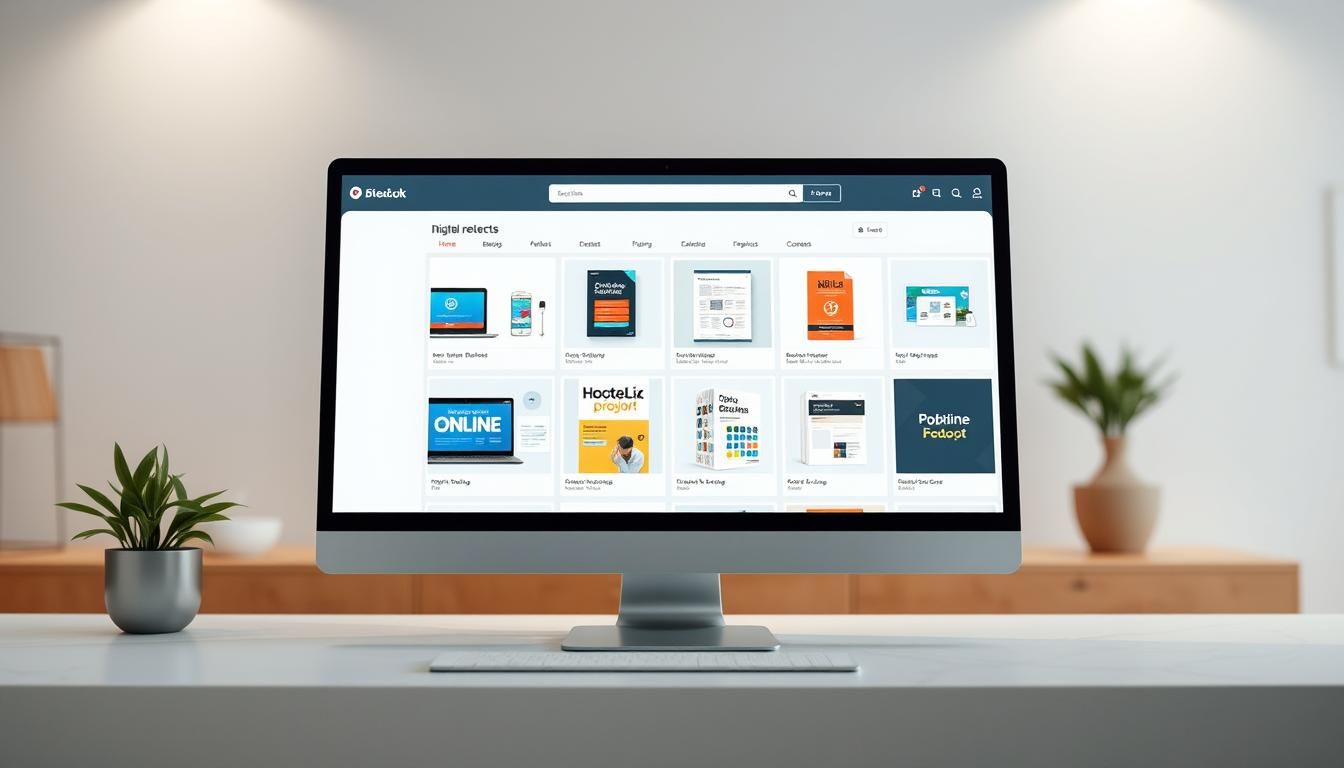Ever thought about turning your skills into something that generates income while you sleep? Imagine waking up to notifications that your expertise—whether it’s designing templates, teaching a skill, or crafting music—is quietly earning revenue worldwide. That’s the power of today’s online marketplace.
Creators like you are reshaping how we think about business. Instead of physical goods, they’re building empires with ebooks, courses, and AI-driven tools. These items require no warehouses, no shipping delays, and no restocking fees. Once created, they can be sold endlessly to a global audience.
The landscape keeps evolving. What started as simple PDFs now includes interactive workshops, members-only content hubs, and even blockchain-secured assets. This isn’t just about making money—it’s about creating value that lasts. Platforms today let you automate sales, track trends in real time, and connect with customers who truly need what you offer.
Key Takeaways
- Scalable opportunities exist for creators in fields like education, design, and tech
- Modern tools automate global sales and marketing with minimal effort
- Subscription models and digital verification boost long-term revenue
- Overhead costs stay low while profit potential grows exponentially
- Emerging trends like AI and blockchain redefine what’s possible
Understanding Digital Product Sales
Imagine owning a business where your creations never run out of stock. Intangible items like ebooks, design templates, or AI tools let creators build sustainable income streams. These assets exist purely online—no shelves to fill or shipments to track.
What Are Digital Goods?
They’re files or access-based offerings delivered instantly through downloads, emails, or platforms. Think video tutorials, printable planners, or even virtual concert tickets. Unlike physical items, they’re copied infinitely without extra costs.

The Evolution of Digital Offerings
Remember when PDFs were cutting-edge? Today’s versions adapt to user behavior. A cooking course might suggest recipes based on dietary preferences, while blockchain tech proves ownership of limited-edition art. Updates happen in real time, keeping content fresh.
Consumers now expect instant access across devices. Subscription libraries and gamified learning platforms thrive because they’re convenient. Creators aren’t just selling files—they’re crafting experiences that evolve with their audience.
Benefits of Selling Digital Products
Creating once and selling endlessly—sound like a dream? It’s today’s reality. Intangible assets like templates, guides, or software tools let creators build income streams that scale without traditional limitations. Let’s explore why this approach works.

Low Overhead and High Profit Margins
Forget renting storage space or negotiating shipping rates. When you sell digital items, your main costs are upfront: creation and marketing. After that, each sale adds pure profit. No restocking fees. No wasted materials.
Here’s why it works:
- No manufacturing delays or defective batches
- Updates reach all customers instantly
- Payment systems handle transactions automatically
Global Reach and Automation Potential
Your store never closes. A customer in Tokyo can purchase at 3 AM while you sleep. Platforms handle currency conversion, tax calculations, and delivery—often for a single flat fee.
automation tools make it a great way to earn passively:
- Email sequences nurture leads
- AI chatbots answer common questions
- Analytics track what’s resonating worldwide
This model isn’t just profitable—it’s sustainable. By eliminating physical materials, you reduce waste while reaching audiences who value instant access.
Top Digital Product Types to Sell
What sells best in the virtual marketplace? Let’s explore three categories thriving right now. Each offers unique advantages for creators looking to monetize their expertise.

Online Courses and eBooks
Online courses remain kings of knowledge sharing. The e-learning sector could hit $848 billion by 2030. Why? People crave structured learning they can access anytime. From photography masterclasses to coding bootcamps, these programs let experts earn while helping others grow.
eBooks complement courses perfectly. They’re snackable guides perfect for commutes or quick reference. A well-researched ebook positions you as an authority—and keeps selling year after year.
Printables, Templates, and Tools
Busy professionals love ready-made solutions. Wedding planners snap up downloadable checklists. Designers stock up on logo kits. These time-saving resources solve specific problems instantly.
Consider seasonal printables like holiday card designs. Customers get immediate satisfaction—they download, customize, and use them the same day. Templates for resumes or social media posts also see steady demand.
Licensed Content and Premium Libraries
Creative assets never go out of style. Photographers license shots to multiple buyers. Musicians sell beats through royalty-free platforms. Bundle your best work into subscription libraries for recurring income.
One stock photo can earn indefinitely. Premium packs with coordinated fonts, graphics, and color palettes help brands maintain visual consistency. It’s smart business—create once, profit repeatedly.
Crafting a Compelling Digital Product Roundup
A well-crafted collection of offerings acts like a curated menu—it guides customers to solutions they didn’t know they needed. Start by grouping items that solve related problems. For example, pair budget-friendly templates with premium coaching sessions. This approach lets buyers see how different products work together.
Balance is key. Mix simple $10 printables with $200 masterclasses. Why? It accommodates both new buyers and loyal clients. One customer might start with a basic planner, then upgrade to an advanced course later. “Variety creates multiple entry points,” says a top creator on Etsy.
Showcase real-world value through visuals. High-quality screenshots of course dashboards or video previews of templates help buyers imagine using your digital products. Before-and-after examples work wonders—like a cluttered spreadsheet versus your organized financial tracker.
Don’t forget social proof. Embed quotes like “This toolkit cut my project time in half” next to relevant items. Stats matter too: 89% of customers trust reviews as much as personal recommendations. Feature success stories that highlight specific benefits, not just generic praise.
Finally, keep your roundup fresh. Swap seasonal items or highlight trending topics. Regular updates signal active engagement, making returning visitors feel confident in your evolving content.
Using social media to Sell Digital Products
Your next customer could be scrolling right now. Platforms like Instagram and TikTok have transformed into vibrant marketplaces where discovery meets instant purchasing. Let’s explore how to turn likes into transactions.
Setting Up Social Storefronts
social platforms now let users buy without leaving the app. Instagram’s shop tabs and TikTok’s product links turn profiles into 24/7 storefronts. Customers can browse your offerings while watching tutorials or exploring trends.
Integrated checkout features reduce abandoned carts. Imagine someone watching a demo of your planner template—they can purchase it mid-scroll. These tools also handle taxes and currency conversions, making global selling digital items effortless.
Driving Traffic Through Engagement
Authenticity wins here. Share time-lapse videos of your design process or quick tips from your course. One creator doubled her ebook sales by posting “Monday Motivation” quotes with actionable advice from her guide.
User-generated content works like magic. Repost customers using your templates with tags like “Show us how you styled it!” This builds trust and shows real-world value. TikTok’s algorithm especially rewards relatable, unpolished clips over overly produced ads.
Remember: every comment is a chance to connect. Answer questions promptly and link to your platform in replies. Consistent interaction keeps your brand top-of-mind when followers are ready to buy.
Choosing the Right Selling Platform
Where you sell matters as much as what you sell. Your platform choice shapes customer experiences, profit margins, and growth potential. Let’s break down how to pick tools that align with your goals.
Comparing ecommerce Solutions
Not all platforms work equally well for every creator. Sellfy shines for beginners with its $19/month simplicity. Shopify offers advanced features at $29/month—ideal for scaling businesses. Need memberships? Podia’s 8% transaction fee plan fits course creators.
Key factors to weigh:
- Customization: Can you match branding colors and fonts?
- Payment options: Do they support PayPal, Stripe, or regional methods?
- Scalability: Will the system handle 10x more downloads?
Recognizing Platform Fees and Flexibility
Some solutions charge monthly fees plus 3% transaction costs. Others take 50% commissions but handle marketing. Gumroad lowers fees to 2.9% as sales grow—perfect for social-first sellers.
Ask yourself:
- Do I need built-in analytics or email tools?
- Can I export customer data if I switch platforms?
- Will seasonal traffic spikes crash my store?
“I switched to self-hosted WordPress plugins and kept 97% of profits,” shares a template designer. While marketplaces offer visibility, they rarely let you own buyer relationships. Balance short-term ease against long-term control.
Designing an Engaging Online Store
Ever walked into a store that instantly felt “you”? That’s the magic of thoughtful design. Your website acts as your virtual handshake—it needs to impress within seconds. Start by choosing templates that mirror your brand’s energy, whether minimalist or bold.
Modern tools let anyone create polished storefronts. AI-powered builders analyze your content to suggest color schemes and layouts. Pre-made themes with built-in features like mobile menus and checkout buttons save hours of coding.
Visual Identity and User Experience
Consistency breeds trust. Use matching fonts and colors across product pages, emails, and social media. A cooking guide creator doubled conversions by using recipe-themed icons in her store navigation.
Speed matters. 53% of visitors abandon sites taking over 3 seconds to load. Optimize images and use caching plugins. Test your website on multiple devices—tablet users should enjoy the same smooth experience as desktop shoppers.
Guide visitors effortlessly:
- Place popular items in eye-catching sections
- Use clear headings like “Start Learning” instead of vague terms
- Add filtering options for price ranges or file types
One Shopify seller increased orders by 40% after simplifying their checkout process to three clicks. As one designer notes: “Your store isn’t just selling—it’s storytelling.” Make every scroll count.
Leveraging AI for Store Design and Marketing
AI isn’t just the future—it’s reshaping how we build businesses today. Creators now use smart tools to design stores and craft campaigns in minutes, not months. These solutions blend human creativity with machine efficiency, delivering tailored experiences at scale.
AI Store Builders and Theme Generators
Forget coding or hiring designers. Describe your brand in plain English, and AI constructs your store’s layout, color scheme, and navigation. One entrepreneur built her template shop in 47 minutes using this method. “It felt like having a design partner who never sleeps,” she shared.
These systems analyze top-performing stores to predict what works. They adjust button placements, font sizes, and image ratios based on real user data. Your site isn’t just pretty—it’s engineered to convert.
Optimizing Content with AI tools
Struggling with product descriptions? AI scans your files and generates catchy titles, bullet points, and SEO-friendly text. It even suggests keywords your competitors miss. One course creator doubled her traffic by letting AI refine her page meta tags.
Personalization goes further. Machine learning tailors your store to each visitor. Returning customers see recommendations based on past downloads. First-time buyers get pop-ups highlighting bestselling items. It’s like having a 24/7 sales assistant.
- Auto-generated email sequences nurture leads
- Social posts draft themselves using trending hashtags
- Predictive analytics flag upcoming demand spikes
As one creator noted: “AI handles the grind so I can focus on what matters—creating.” These tools don’t replace creativity—they amplify it.
Optimizing Product Pages for conversions
What’s the secret ingredient that turns browsers into loyal buyers? It’s crafting pages that blend irresistible visuals with crystal-clear communication. Your listing isn’t just a description—it’s a confidence-building experience.
High-Quality Visuals and Descriptions
Sharp images act as your silent sales team. Use lifestyle shots showing templates in action or video snippets previewing course features. Natural lighting and consistent angles make items feel professional yet approachable.
Pair visuals with descriptions that answer “What’s in it for me?” A budgeting spreadsheet isn’t just cells and formulas—it’s “36 hours saved annually through automated calculations.” Highlight outcomes, not just specs.
Effective Call-to-Actions
Guide visitors gently toward purchase. Instead of generic “Buy Now,” try “Start Your Design Journey Today” for creative templates. Place buttons where eyes naturally land—after benefit lists or customer testimonials.
Limited-time offers work wonders. “Join 500+ learners this week” creates urgency without pressure. Test button colors and phrasing to see what resonates best with your audience.
Useful Resources
For additional insights, check out these valuable resources:
- e-commerce best practices - Shopify
- e-commerce marketing strategies - HubSpot
- online store optimization - BigCommerce
- WooCommerce insights - WooCommerce
- e-commerce usability research - Baymard Institute
FAQ
What types of downloadable items can I sell online?
Popular options include eBooks, online courses, design templates, stock photos, software tools, and licensed audio/video content. These items cater to diverse audiences, from entrepreneurs to creatives.
Why do downloadable goods often have higher profit margins?
Unlike physical items, there’s no inventory storage or shipping costs. Once created, you can sell copies endlessly through platforms like Shopify or Gumroad with minimal recurring expenses.
How do platforms like Etsy handle fees for digital sales?
Most platforms charge listing fees (e.g., $0.20 per Etsy listing) plus 3-10% transaction fees. Some, like Teachable, use subscription models. Always compare fees against features like built-in audiences or customization options.
Can Instagram and TikTok really boost my template sales?
Absolutely. Short videos showing template customization or time-saving benefits perform well. Use Pinterest for evergreen content and TikTok challenges to showcase your printables in action.
What makes AI tools useful for store design?
Tools like Canva’s Magic Design or Wix’s ADI quickly generate logos, color schemes, and layout ideas. They analyze trends to suggest visuals that align with your niche, saving hours of manual work.
How crucial are product videos for conversions?
Pages with demo videos convert 30% faster on average. Show tools in action or include course previews. Pair crisp screenshots with benefit-driven descriptions like “Save 10 hours/month with our Excel templates.”
Should I price my eBook lower than physical books?
Not necessarily. Focus on value—if your guide solves a $500 problem, $49.99 is reasonable. Bundle extras like checklists or community access to justify premium pricing.
How do I protect my digital art from being copied?
Use watermarks on previews, limit download attempts via platforms like SendOwl, and add license agreements. For courses, host videos on password-protected sites like Thinkific or Kajabi.
Can I sell the same templates on multiple platforms?
Yes, but tailor listings to each audience. Etsy shoppers love niche aesthetics, while Creative Market buyers seek professional-grade tools. Adjust keywords and imagery accordingly.
What’s the fastest way to start selling without a website?
Use all-in-one solutions like Ko-fi or Payhip. They handle payments, delivery, and basic storefronts. Promote directly through social bios or Linktree until you’re ready to scale.
